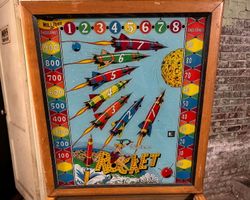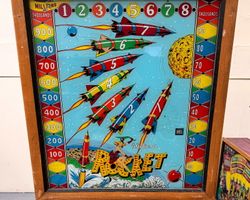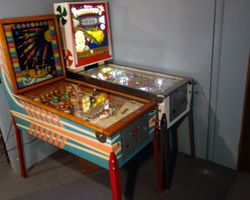
Average Prices: USD $1,200 to $2,500
Produced: November, 1959
Machine Type: Electro-mechanical
Players: 1
Design by: Harry Williams
Art by: George Molentin
The year 1959 marked a pivotal moment for Williams Electronic Manufacturing Company with the introduction of "Rocket," an electro-mechanical (EM) pinball machine that captured the imagination of players with its ambitious space-age theme. At a time when the world was gripped by the burgeoning space race, "Rocket" offered a tangible, interactive exploration of the cosmos right in the arcade. The machine was conceived and designed by Harry Williams, a prolific figure whose contributions spanned the conceptualization, animation, and mechanical engineering of the game. George Molentin, a significant artist for Williams, brought the vivid, interstellar world of "Rocket" to life through his distinct artistic style.
Development for "Rocket" began months before its release, with original playfield drawings dated February 12, 1959, and a master copy finalized by May 20, 1959. This meticulous design process culminated in the machine's official release on November 12, 1959, under model number 224. "Rocket" entered a competitive market but quickly established its presence with a compelling theme and innovative mechanics, offering players five balls for a mere five cents—a testament to the era's value and accessibility. Notably, early production units of "Rocket" featured a deep purple background on the backglass, aligning with the darker imagery presented in promotional flyers, distinguishing them from later versions with a lighter blue hue. This detail offers a glimpse into the subtle variations that can emerge within a production run, making these early examples a point of interest for pinball machine collectors.
Signature Features and Design
"Rocket" distinguishes itself not through complex toys or elaborate contraptions, but through the seamless integration of its captivating space theme with fundamental EM pinball mechanics. The machine's primary allure lies in its vibrant artwork, particularly the backglass, which depicts a dynamic scene of astronauts, celestial bodies, and rockets in flight, setting an immediate tone of cosmic adventure. The playfield artwork mirrors this theme, with detailed illustrations of planets, stars, and launch pads guiding the player's eye and reinforcing the central objective. This visual coherence is paramount, creating an immersive experience even with the simpler display technology of mechanical reels.
The core of "Rocket's" design centers around its unique objective: to "launch" seven individual rockets, each corresponding to a numbered kick-out hole on the playfield. This sequential progression is more than a simple scoring mechanism; it is the narrative spine of the game. The "blast off" feature, tied to a series of countdown saucers, adds an additional layer of anticipation and visual feedback as players strive to light up the entire playfield, signifying a successful launch sequence. These elements, combined with the strategic placement of five passive bumpers and four pop bumpers, transform the playfield into a dynamic launchpad where every shot contributes to the overarching goal of space exploration. The design philosophy of "Rocket" emphasizes player engagement through a clear, thematic objective, making the journey to complete the rocket sequence the primary driver of replayability and enjoyment.
Playfield and Mechanics
The playfield of "Rocket" is a masterclass in elegant simplicity and strategic depth, a hallmark of Harry Williams' design philosophy. It features a layout that immediately conveys its space theme, with seven distinct kick-out holes strategically placed across the upper and mid-playfield, each labeled with a rocket number from one to seven. The two flippers are positioned closely together at the bottom, providing precise control, a necessity given the game's challenging nature. Above the flippers, two slingshots on either side act as reactive elements, deflecting the ball unpredictably and demanding quick reflexes.
The primary objective involves systematically launching each of the seven rockets, a task made challenging by the dynamic nature of the upper lanes. Once a ball enters an upper lane, it often leaves the upper playfield, making subsequent attempts to change the active rocket number via those lanes particularly difficult. The playfield is also populated with five passive bumpers and four pop bumpers, positioned to create chaotic yet controllable rebound paths, influencing ball movement towards the various kick-out holes.
Visually, the playfield is adorned with George Molentin's distinctive artwork, featuring a palette of bold colors that bring the cosmic landscape to life. Planets, stars, and rocket launch zones are intricately depicted, enhancing player immersion. The mechanical reels, serving as the score display, complement the vintage aesthetic, clicking and whirring as points accumulate and rockets are "launched." The lighting scheme, while simpler than modern machines, effectively highlights active targets and the "blast off" sequence, guiding the player's focus and signaling progress. The thoughtful integration of artwork and mechanical elements ensures that every interaction on the playfield feels purposeful, contributing to the game's overall flow and the player's pursuit of a full rocket launch.
Gameplay Dynamics
"Rocket" offers a gameplay experience that is both demanding and deeply rewarding, rooted in precision and strategic shot-making. The central objective revolves around launching the seven rockets in a specified sequence. Unlike some machines where objectives can be circumvented for high scores, "Rocket" compels players to actively pursue the rocket progression. Each kick-out hole, once triggered, counts as a launched rocket, pushing the player closer to the ultimate goal. The true challenge lies in controlling the ball to reliably hit these specific holes and, more critically, to manipulate the rocket number via the upper lanes, a task noted for its significant difficulty once the ball has descended from the upper playfield.
Scoring in "Rocket" is intrinsically linked to this progression, with significant points awarded for successful rocket launches and sequence completions. Beyond individual rocket launches, the game rewards sequences: launching three rockets in a row grants one replay, four in a row earns two, and successfully launching all seven rockets awards five replays, a substantial incentive that fuels extended play sessions. This replay system ensures that skill and perseverance are directly rewarded, fostering a sense of achievement with each completed sequence.
A unique skill shot involves hitting a specific top hole to select a rocket, a maneuver that demands precise plunger control and serves as an immediate test of a player's mastery. Mid-playfield, a series of saucers trigger a "blast off" countdown from five to one. Successfully completing this countdown lights up the entire table, a visual and auditory cue that signifies a critical milestone in the game, akin to a mini-objective that contributes to the overall cosmic journey. While accumulating points from the pop bumpers can be a more straightforward path to a high score, the game's enduring appeal lies in the pursuit of the rocket sequences, which requires a different, more strategic approach. The machine plays remarkably fast for an EM of its era, demanding constant attention and quick reflexes. The dual outlanes are particularly unforgiving; balls that drift to the sides are generally lost, reinforcing the need for precise flipper work and ball control. This relentless pace and the high stakes of losing a ball contribute to "Rocket's" reputation as a "ball buster," a game that challenges even experienced players.
Reception and Legacy
"Rocket" garnered an overwhelmingly positive reception within the pinball community, quickly establishing itself as a standout electro-mechanical machine from 1959. Players consistently praise its captivating gameplay, often describing it as challenging, addictive, and possessing excellent replayability. Many enthusiasts, even those who typically favor more modern designs, find themselves drawn to "Rocket's" unique charm and demanding mechanics.
The machine's strengths are multifaceted. Its artwork, particularly the backglass and vibrant playfield, is frequently lauded as "beautiful" and "hot," contributing significantly to the machine's aesthetic appeal and reinforcing its compelling space-age theme. The playfield layout is hailed as unique and strategically well-designed, with the sentiment that "every shot matters" resonating deeply with players who appreciate precision. The closely placed flippers are noted for allowing longer ball-playing times, a welcome feature given the game's inherent difficulty. The core "rocket collection" mechanic is consistently highlighted as its most distinctive feature, requiring players to systematically pursue all seven rockets, thereby dictating a focused and strategic approach to gameplay. The "blast off" countdown feature and the satisfying replay awards for completing rocket sequences also contribute to its high regard.
While the overwhelming feedback is positive, some players note the absence of a "save" feature as a minor point, making the unforgiving outlanes a constant threat. The skill shot, particularly hitting the top hole to select a rocket, is considered exceptionally difficult, a testament to the machine's high skill ceiling. Despite these challenges, its fast pace for an EM machine and its ability to keep players engaged through its demanding yet rewarding progression solidify its reputation.
"Rocket" occupies a significant place in pinball history, not just as a well-regarded EM machine, but as a testament to Harry Williams' innovative design principles. Its emphasis on a clear, sequential objective rather than mere point accumulation influenced subsequent EM designs by demonstrating how a strong thematic hook could drive player engagement. It remains a desirable "keeper" for many collectors, valued for its unique gameplay, beautiful artistry, and the pure, unadulterated challenge it presents. Its legacy is one of a machine that transcended its era's typical design conventions, proving that a demanding, skill-based experience, wrapped in an appealing theme, could create an enduring and beloved pinball classic.
Sponsored Links
 Ebay Listings
Ebay Listings
 Auction Results
Auction Results
| Cost | Location | Date |
|---|---|---|
| USD $2,034 |  Wisconsin, United States Wisconsin, United States |
20 April, 2025 |
| USD $1,200 |  Massachusetts, United States Massachusetts, United States |
17 April, 2025 |
| USD $1,400 |  Ohio, United States Ohio, United States |
12 September, 2024 |
| USD $3,000 |  Missouri, United States Missouri, United States |
24 June, 2020 |
| USD $1,395 |  Pennsylvania, United States Pennsylvania, United States |
16 January, 2012 |


Private Policy · Search Website · Contact Us
As an eBay Partner, we may earn a commission from qualifying purchases made through links on this site, at no additional cost to you.
All trademarks and copyrighted materials remain property of their respective owners. All other content copyright 2007 - 2025 Pinpedia.




